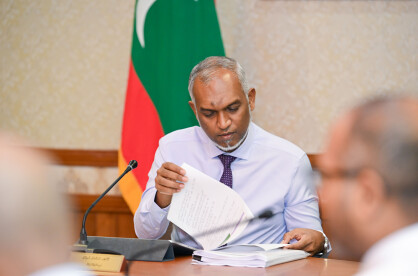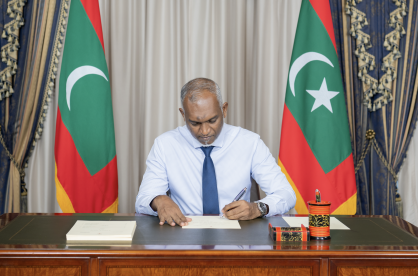Who pays the bills
Taxation should be more equitably imposed; it should not keep sections of society hovering on the poverty line.

MFR Graphic
Taxation should be more equitably imposed; it should not keep sections of society hovering on the poverty line.

MFR Graphic
The Maldivian parliament approved a budget over MVR34 billion for 2021, despite the forecasted decline in revenue since 2020, mainly due to the COVID-19 pandemic. Pre-COVID, in 2019, the government budget recorded over MVR23.3 billion in revenue — 27 percent of GDP — which is in line with developed countries in terms of revenue per GDP.
Since the comprehensive tax system established in 2011, the Maldives government budget is financed mainly by tax and non-tax revenues, in addition to the over 20 percent share of borrowings. The year 2019 has been the best year so far in tourism, with over 1.7 million visitors. Despite the record high total revenue received, the year ended with over MVR5 billion in borrowings to finance the budget.
Taxes contribute over 71 percent of total revenue collection, with non-tax revenue having a 24 percent contribution. Grants from bilateral and multi-lateral donors contribute five percent to total revenue and grants.

The Maldives’ tax system incorporates almost all the types of taxes levied in the world. Starting from Import Duties, Goods and Services Taxes, Business Profit Tax, Royalties on Exports, Green Tax, Remittance Tax, and Revenue Stamps. The total revenue from all these taxes amounted to MVR16.5 billion in 2019. The highest contribution came from the GST on the tourism sector, while Business Profit Tax (BPT) contributed 15 percent with MVR3.5 billion.

Over 30 percent of the total revenue was contributed by tourists, mainly in the form of T-GST, Airport Service Charge, Green Tax, and Airport Development Fee. The total collection in 2019 amounted to over USD458 million, averaging around USD1.2 million per day, and USD270 per visitor.
In addition, companies operating resorts and hotels contributed over MVR3.7 billion — USD246 million — during the same year, which is about 16 percent of total revenue. The resorts paid Land Rent, Lease Extension Fees, and BPT.

The Maldives collects import duties on most imported goods, and collected over MVR 3.4 billion in 2019 — this translates to 15 percent of total revenue. While goods are taxed as they are imported, consumers pay taxes in the form of Goods and Services Tax (GST) when goods are purchased as well. Total collection from GST from general goods and services excluding the tourism sector, is MVR2.8 billion — roughly 12 percent of total revenue. The GST rate on general goods and services excluding the tourism sector is at six percent, while the sales of tourism sector is taxed at 12 percent.
On average, every person in the Maldives pays about MVR20 to the government every day as GST alone. This means, the resident population in the Maldives pays about MVR7.8 million per day to the government budget from their daily consumption.

That is not all. The non-tax revenue component is about 24 percent of total revenue — around MVR5.6 billion in total per year — mainly in the form of fees, fines, and dividends from state owned companies. More than MVR154 million was collected from the public in 2019, as fines or other levies, for falling afoul of laws and regulations. Further, total collection from fines and penalties amount to MVR235 million.
There is no denying that a proper tax system, which is fair and efficient, is necessary in order to finance government expenditure on public goods and other development services. Other objectives of the system should undoubtedly include fair and equitable distribution of income and wealth in society. Additionally, specific targeted taxes and fees are imposed in order to finance specific areas of development. Some examples in the Maldives include the Green Tax and the Airport Development Fee. Every tourist staying in a resort is required to pay USD6 per night, and a tourist staying in a guest house USD3 per night as green tax. In 2019 MVR850 million — USD 55 million — was collected as Green Tax. It will be very much in the interest of those visitors who pay these taxes to know how much of this revenue is actually utilised on green-projects and on protecting the environment.
More than MVR733 million — USD47 million — was collected as the Airport Development Fee in 2019, out of which tourists paid USD42 million and Maldivians paid a total USD5 million. With an ambitious airport development project underway, and more than USD800 million already incurred in debt on the project, there is a clear expectation that the proceeds from the Airport Development Fee will indeed be utilised for what it says on the tin.
Similarly, when more than MVR235 million is collected per year from violations of laws and regulations, it is entirely valid for the citizen to ask how much of this revenue is actually spent on awareness and rehabilitation, so that people become law abiding citizens. Or is it in the interest of the government to further increase this revenue component? Current trends indicate that this might, myopically, be the case.
This year marks ten years since the introduction of the tax system in the country, and the fiscal affairs department at the Ministry of Finance is yet to conduct a review of the tax policies of the state, to determine fairness, efficiency and sustainability when it comes to taxation. With tax revenue at almost 30 percent of GDP, the Maldives' government revenue is among the highest in the world in terms of GDP, similar to developed European countries. Which, in itself, might be admirable.
However, the question arises whether the tax system is fair and equitable. Does the nation’s tax regime achieve even distribution of income and wealth within society? With the Maldivian citizen having to pay import duties, together with GST, Income Tax, and tonnes of fees and levies on top the tax system, is quite regressive.
The overall burden of the tax is proportionately much higher on the poor. A fair tax system would be more progressive, with people in higher income brackets bearing a higher percentage of the tax — it should not be a mechanism that prolongs the average citizen hovering on the poverty line.



